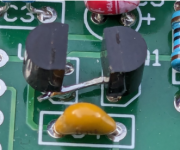SirRichard42
Member
- Joined
- May 29, 2022
- Messages
- 12
Hello,
A couple of years ago one of my friends gave me a bare FreHD v3.01 board, despite the fact that I have never owned a TRS-80 model 1/3/4/etc computer. Then a few months ago a different friend gave me a diskless Model 3 computer with 32k of RAM. I cleaned it up, fixed the keyboard, and upgraded it to 48k of RAM. I also built up the FreHD board but it doesn't work. I'm hoping to get some advice on how to go about troubleshooting this thing. I have a lot of experience with Tandy Coco 1/2/3, Commodore 64, Amiga, etc computers but I have never used the Model 3.
I built everything on the FreHD from scratch so the problem could lie anywhere. I made the cable: 50pin female header to 50-pin edge card connector with 1 meter of IDC cable. I programmed the GAL 16v8 and PIC 18F4620 chips with a TL866IIplus, and the 2kib ROM-C boot eprom with a Willem v3 programmer. I formatted an 8GB SDHC card with a FAT32/LBA (type C) partition, and copied all of the files in Frehd-SD.zip into it.
I power up the FreHD and the green LED blinks when it first gets power. It also blinks when I insert the SDHC card. When I turn on the Model 3, it just gives me the usual "Cass?" and "Mem?" prompts and then goes to BASIC. I have a scope and logic analyzer and know how to use them. How should I go about troubleshooting this thing to figure out what's wrong?
Thanks,
Richard
A couple of years ago one of my friends gave me a bare FreHD v3.01 board, despite the fact that I have never owned a TRS-80 model 1/3/4/etc computer. Then a few months ago a different friend gave me a diskless Model 3 computer with 32k of RAM. I cleaned it up, fixed the keyboard, and upgraded it to 48k of RAM. I also built up the FreHD board but it doesn't work. I'm hoping to get some advice on how to go about troubleshooting this thing. I have a lot of experience with Tandy Coco 1/2/3, Commodore 64, Amiga, etc computers but I have never used the Model 3.
I built everything on the FreHD from scratch so the problem could lie anywhere. I made the cable: 50pin female header to 50-pin edge card connector with 1 meter of IDC cable. I programmed the GAL 16v8 and PIC 18F4620 chips with a TL866IIplus, and the 2kib ROM-C boot eprom with a Willem v3 programmer. I formatted an 8GB SDHC card with a FAT32/LBA (type C) partition, and copied all of the files in Frehd-SD.zip into it.
I power up the FreHD and the green LED blinks when it first gets power. It also blinks when I insert the SDHC card. When I turn on the Model 3, it just gives me the usual "Cass?" and "Mem?" prompts and then goes to BASIC. I have a scope and logic analyzer and know how to use them. How should I go about troubleshooting this thing to figure out what's wrong?
Thanks,
Richard


